Bills Would Hold R.I. Agencies Accountable for Meeting Climate Goals
April 27, 2024
PROVIDENCE — State leaders have set dozens of ambitious climate goals over the past decade, but what example is Rhode Island government setting?
That’s the question asked by a number of bills under consideration in the General Assembly this year that aim to help state government reduce climate emissions, improve purchasing of electric vehicles and renewable energy, and uphold the goals laid out in the 2021 Act on Climate law.
“It’s important [state government] set a good example for trying to engage in actions that will reach the climate goals of the state,” said Sen. Alana DiMario, D-North Kingstown, in a Senate Environment Committee hearing last month. “It’s an important step for the government to know what it looks like when we ask businesses to perform many of these same changes.”
DiMario’s bill (S2541) would require the Executive Climate Change Coordinating Council (EC4) to develop a template for state agencies to use to track their emissions. The template data would include an agency’s electricity usage, information on their vehicle fleet, and any renewable energy systems. Under the proposed law, agencies would have until July 1, 2026, to provide the data, and update it every five years afterward.
It’s not the only bill to force state government to practice what it preaches. Sen. Joshua Miller, D-Cranston, introduced a bill (S2543) that would change what the state can and cannot purchase for itself. Chief among its changes is a prohibition on state government to buy single-use plastic water bottles when a public water supply is available. The legislation would also codify into law a number of goals state government has set for itself regarding electric vehicles and electric vehicle charging stations.
Such goals currently only active via a pair of executive orders issued by the last two gubernatorial administrations. In 2015, then-Gov. Gina Raimondo issued Executive Order 15-17, which created a Lead by Example program within the state Office of Energy Resources and outlined a number of goals for state government to reach by 2025.
Among the goals Raimondo set? Offsetting 100% of electricity purchased by the state by renewable resources by 2025, transitioning at least 25% of the state fleet, around 625 cars, to zero-emission or electric vehicles by 2025, and reducing the total energy consumption of state government 10% below fiscal year 2014 levels.
How has the state fared with its own goals? There’s some good news, some bad.
Robert Beadle, a spokesperson for OER, said the state had achieved offsetting all of the electricity consumed by state agencies, and 14% of the state’s light-duty fleet were zero-emission vehicles.
But that number is still around 300 cars short of Raimondo’s original goal of 25% by 2025. State leaders were aware of that figure too. The Providence Journal reported last fall that Gov. Dan McKee signed an executive order last year extending the deadline for transitioning the state fleet by an additional five years after the state fell behind on its goals.
“While the path to full electrification and net-zero emissions is challenging,” Beadle wrote in a statement to ecoRI News on the goals in the 2023 executive order, “the strides we have made thus far are encouraging and demonstrate we are on track to achieve the targets outlined in the Executive Order.”
The state also achieved another of Raimondo’s original goals; by 2019 it had reduced its total electricity usage by more than 10%. McKee’s new executive order has increased this goal to 20% reduction by 2030.
The new executive order also mandated the state build 200 electric vehicle charging stations by 2030. Currently, the state has 68 charging stations on state properties. Rhode Island received $23 million in formula funding for the National Electric Vehicle Infrastructure program last year. Two EV charging stations have already been installed, at the Route 117 Park & Ride lot in Warwick and another at the Ashaway Park & Ride lot in Hopkinton.



